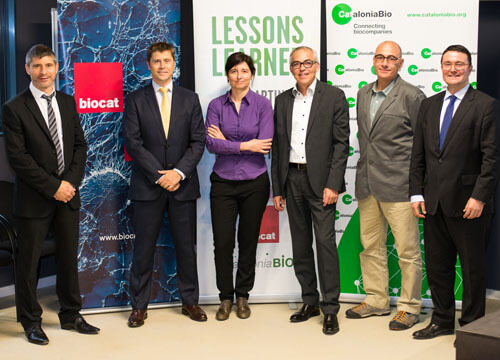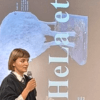
Patent, from corporate credibility to technology or research protection
The successes and failures when designing an IP strategy for a product or technology in the field of life sciences; the main aspects to be taken into account when preparing the strategy for the management of intellectual property and how and in which countries it is most advantageous to internationalize a patent are some of the issues that were put on the table for discussion at the last workshop Lessons Learned, organized by the business association CataloniaBio and Biocat on 21 of May at the Parc Científic de Barcelona (PCB).
During this session, attendees could learn from the personal experience of the experts. The participants talked about pantents, emphasizing the protection strategy of technology, process and product, on what is the best time to protect and what are the risks that SMEs should consider. Also. they discussed about IP from different points of view: large enterprises, SMEs, consultants, start-up, etc.
“There is no more tangible way to quantify technology than with a patent. It’s an issue that we’ve been very concerned about ever since we started the company,” explained Lluís Ribas, founder and CSO of Omnia Molecular at this session of Lessons Learned. Omnia Molecular researches new antibiotics and antifungal medicines using their own screening strategies. Their approach to intellectual and industrial property has evolved and they now have two patents protecting their technology in nearly all the world. In 2005, when the company began as a spin-off of ICREA, IRB Barcelona and the PCB, “Generating patents wasn’t a priority. We were deterred by the cost and the time it required,” said Ribas. What tipped the scales in favor of patenting was “The peace of mind patents gave the institutions we came out of, but what we wanted was to find drug candidates,” specified the founder of Omnia. And, from 2008, with our first investors, “We decided that protecting our technology with alternative methods was more effective.”
From the point of view of a research center, Elisenda Vendrell, director of the Knowledge and Technology Transfer Office at August Pi i Sunyer Biomedical Research Institute (IDIBAPS)-Hospital Clínic, believes it is necessary to strengthen the following aspects: protecting when it is possible and there is a potential for return, initiating conversations with industry from the very beginning, notifying researchers of the transfer process and its returns and keeping them involved at all times. Based on the concept that the institution holds the patent and the researchers are listed as the inventors “and they don’t always understand it that way, so it is important to communicate this clearly,” said Vendrell.
IDIBAPS-Hospital Clínic currently has 62 active families of patents (many held jointly with other institutions), 10 registered software programs and 232 licensing, collaboration and alliance agreements. Although each center has its own internal policy, IDIBAPS “shares the exploitation benefits equally among the inventors, the research group and the institution. And this is an incentive for them to continue doing research,” Vendrell explained. She also recognized that “we are increasingly asked for the impact it will have on society, whether economic or by generating employment, a new drug or diagnostic tool for a specific disease.”
For Vendrell “publishing and patenting aren’t incompatible,” while Nicolás-Vincent Ruiz, head of IP at Esteve, gave a good example of a common practice that consists in first filing the patent application and then publishing the scientific paper. Several professionals from the audience at the Lessons Learned session added to the debate. “There’s a lot of pressure to patent so, from the standpoint of a biotechnology or biopharmaceutical company, patents are filed too early with little support or clinical validation,” said Marta Palicio, head of Innovation at Biokit. “You find you have a promising project, but with minimal development requiring a huge investment. For the company it’s difficult to decide to license and I understand that the return in these cases may come after 15 years,” she added.
Attractive strategy focusing on future partners
Afterwards, Nicolás-Vincent Ruiz explained some of the lessons he has learned at the helm of the intellectual property department of this Catalan multinational corporation. When working on protection strategy, he recommends taking into account the criteria that pharmaceutical companies seek in licensing a project. This is why you have to establish an attractive strategy (selecting assets to protect, prioritizing patent applications, countries and phases depending on the resources for each project, etc.), legal security and a project with business-oriented value added.
The executive at Esteve emphasized that legal certainty can affect the company’s legitimacy to negotiate and license. It is important, therefore, to identify the main stakeholders and their rights “because we will enter the market,” he explained. Also, defining all the aspects of the contract, the obligations of each partner in the collaboration, the rights (of the real inventors, their work situation, etc.) and how information is managed, meaning taking into account how, when and who we share with.
“We have to build trust and reputation,” said Josep Maria Carulla, director of Marsh Risk Consulting Iberia and “be aware that during the lifespan of a patent, we can come across many different risks in terms of strategy, operations, reporting and compliance.” Companies that think about risk on a daily basis are more able to identify it and know what can happen, to prioritize management and avoid some critical situations. This consultant specializing in the life sciences believes “we are talking about a dynamic process, we have to have a culture of risk and decision making.” And he admits that “tolerance for surprises and errors is increasingly low.”
Communication and transparency with partners and investors
On the legal side, Javier Merino, founder and managing partner of Innovatech Law Firm, explained that technology can be protected through intellectual property (computer programs, databases, bioinformatics, mobile applications for health, technical manuals, etc.),industrial property (patents, brands, etc.) or industrial secret (know-how). Intellectual property protects the technology from the moment of creation, no registration is required, except for proof of ownership “and in this case there are tools like notary filing or the intellectual-property registry.” In terms of industrial property, to patent technology it must meet specific requirements like novelty, inventive activity and industrial application.
Regarding licensing contracts, it is important to take into account the aspects that will govern it and the definition of the technology licensed, the territory, length, improvements, patent-maintenance expenses, patent-defense expenses, any possible sublicensing, among other issues.
Moreover, “proper management of communication throughout the process and transparency will help us gain the support of partners and investors,” said lawyer Javier Merino. Turnout at the event was great, with more than fifty professionals filling the multipurpose room at the PCB, moderated by Bernabé Zea, partner at ZBM Patents and member of the Patent Center at the University of Barcelona.
The next Lessons Learned session will be on 9 July and will cover the process of negotiating licensing agreements and with investors.




